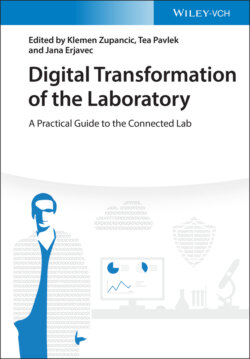Читать книгу Digital Transformation of the Laboratory - Группа авторов - Страница 27
1.2.6.2 New Science in the Life Sciences Domain
ОглавлениеAs discussed in several of the earlier parts of this section, there is one critical, global driver which will dominate new science and how it is performed in the LotF; that key driver is climate change and the supporting concept of “sustainability”. There will be new research looking specifically into climate change and sustainability as areas of interest in themselves, but the need for the LotF, both the hypothesis‐ and the protocol‐driven lab, to be more sustainable, less dependent on oil and oil‐based products, and yet be more efficient, will become paramount in the decades to come. Labs that do “chemistry” will be a primary focus for these developments, but biology‐focused labs will not be immune. The pressure to be more environmentally friendly, using fewer reagents and disposable materials, will lead to new research to discover, for example effective replacements for all the lab plastics currently used; greener chemistry (use of less‐toxic solvents and reagents); greater use of catalysts; and more use of biological systems to perform complex chemical transformations. None of these examples are exactly new, but their importance and greater use in the LotF will be significant.
Just as the next generation of scientists is exquisitely conscious of the environment, so too is it particularly focused on animal welfare. The ever‐growing drive toward minimization of the use of animals in research and product testing, while it can never in truth be completely eliminated, will continue to accelerate. Initiatives such as the “3Rs” [101] looking to replace, reduce, and refine the use of animals in the lab will gain more traction [102]. In vitro approaches to meet the goals of the 3Rs will include developments such as organ‐on‐a‐chip [103] and the increasing use of stem cells. These new methods will become widespread in the LotF.
Finally, there is one lab technique, which has been a mainstay of the lab for hundreds of years, yet is still undergoing significant evolution and is likely to feature significantly in the LotF: microscopy. Advances in traditional imaging revolutionized life sciences over a decade ago, but current developments in microscopy are likely to transform utterly how in the future we perceive “things” both at the molecular and macromolecular levels. There are two specific examples, which we feel are worth mentioning here: firstly, the scanning tunneling microscope (STM) [104] and secondly, the cryo‐electron microscope (cryo‐EM) [105]. STM and other comparable new microscopy techniques [106] have the potential to take to an even higher level our ability to study cells, solid‐state materials, and many other surfaces. STM has clear potential applications in biology, chemistry, surface science, and solid‐state physics [107]. The STM, which operates through the principles of quantum tunneling, utilizes the wavelike properties of electrons, allowing them to “tunnel” beyond the surface of a solid into regions of space that are normally forbidden under the rules of classical physics. While the use of STM has been focused mainly on physicochemical and solid‐state challenges, increasingly scientists are looking at STM as a means to see more deeply into chemical and biochemical systems, right down to the atomic level [108]. Cryo‐EM is the electron microscopic imaging of rapidly frozen molecules and crystals in solution. It demonstrates its main benefits at the macromolecular level, enabling scientists to see the fine structures of proteins, nucleic acids, and other biomolecules, and even to study how they move and change as they perform their functions, but without having to use the intense electron beams and high vacuum conditions used in traditional electron microscopy [109].
